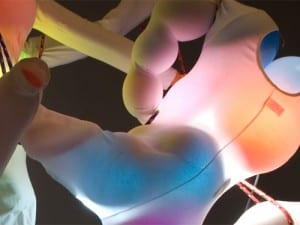30 Americans at Contemporary Arts Center New Orleans (CAC), running until 15 June, explores identity through the eyes of some of the most important African American artists of the last thirty years. Through the use of mixed media, real-life objects, lighting, photography, drawing, painting, sculpture, video and collage, many of the artists deal with the struggle to disregard stereotypes in order to create their own images.
Glenn Ligon’s world-renowned neon sign stating “I sell the shadow to sustain the substance” is one of several works that portrays the idea of conforming as a tool for overcoming judgment. It is a quotation taken from Sojourner Truth, one of the most famous African American women and civil rights activists of the 19th century. Jeff Sonhouses’s oil on canvas Visually Impaired and oil and mixed media on wooden panel Exhibit A: Cardinal Francis Arinze show two upright black men hidden behind masks, sunglasses, capes and distracting patterned backgrounds. These garish costumes illuminate how people strategically mask themselves.
Lorna Simpson’s wigs shows a portfolio of 21 wigs on felt accompanied by quotations such as “choosing which wig to wear always took a moment or two to decide” and “Gladys Bentley appeared at a night club in LA in 1940 – The club had to get a special permit to – “Allow Gladys Bentley 250 pound colored entertainer to wear trousers instead of skirts during her act”. These statements represent the symbolic relationship African Americans have had with their hair. The wig, an accessory which covers the head, is another item that masks the person who wears it. Unlike the absurd outfits in Jeff Sonhouse’s work, the wig is not always perceived negatively by its owner, but is sometimes worn by women to emphasize their beauty.
Many of the artists use the body, sometimes their own, to question beauty ideals. Carrie Mae Weems, an artist who currently has a retrospective at The Guggenheim in New York, places text across images as a commentary on the historically oppressive ways black figures have been understood and categorized. Four photographs of vulnerable looking men and women with bare chests and tired expressions have captions like “you became a scientific profile,” “an anthropological debate” and “a photographic subject.”
In The Evolution of Mud Mama from Beginning to Start, Kenyan-born Wangechi Mutu uses watercolor, gold leaf and clippings in six collages of abstract images that resemble female body parts like large, sagging breasts, thick thighs and deformed nipples. The provocative work beckons an evaluation of what it means to be a woman. It also shows the many ways bodies can be displayed, shaped and transformed both in art and real life.
30 Americans represents the process by which many of the most influential African American artists have come to understand their identities since the 1970s. The works exhibited tackle themes from the civil rights movement to the exploitative nature of modern-day capitalism. It reveals the complex and changing relationship between one’s self and the external world. As the viewers inevitably project opinions onto the art, it further complicates questions about how all people, not just African Americans, can understand themselves and one another.
Shelby Hartman
30 Americans, running until 15 June, Contemporary Arts Center New Orleans 900 Camp St, New Orleans, LA 70130
For more information visit: cacno.org
Credit:
1. The New Negro Escapist Social and Athletic Club (Thurgood) Rashid Johnson (2008). Courtesy of Rubell Family collection, courtesy of David Kordansky Gallery, Los Angeles




